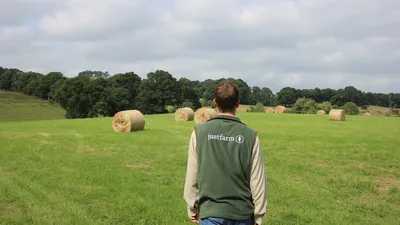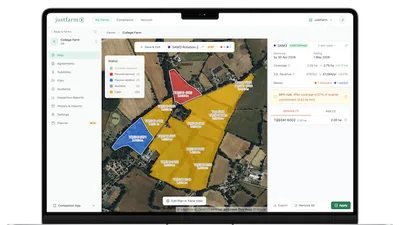MOR1 - Assess moorland and produce a written record
Payment
You’ll receive £10.60 per hectare and £272 per SFI agreement per year.
Aim
This action’s aim is that you understand how your moorland contributes to providing environmental benefits and how it could provide more in the future.
Where You Can Do This Action
You can do this action on eligible land located above the moorland line. You can check MAGIC to find out if your land is above the moorland line.
Table 9: Eligible Land for MOR1
| Eligible land type | Eligible land use code | Compatible land cover |
|---|---|---|
| Moorland | PG01 | Permanent grassland |
| Non-agricultural areas, such as scrub, scree, bracken and bog | Non-agricultural | Other (non-agricultural) |
The glossary (annex C) explains what we mean by land types, land use codes and compatible land covers.
The SFI application service will automatically calculate what area may be eligible for this action in each land parcel. This is called the ‘SFI available area’. You must check this area is an eligible land type. Find out how the SFI available area is calculated in the information on land that’s eligible for the SFI actions (section 4.1.2).
You can only apply for this action on the total SFI available area in each land parcel shown in your SFI application. You cannot apply for it on part of that area.
This action is static. You must do it on the same area of eligible land each year of your 3-year SFI agreement. You cannot move the area around each year.
You cannot enter land above the moorland line into this action if it’s:
- farmyards
- used for turf or peat production
You also cannot enter a land parcel into this action if the majority of its area is located below the moorland line or it’s permanent grassland below the moorland line.
Other Land Management Actions or Options You Can Do on the Same Area as MOR1
The table below sets out which other SFI actions, CS management options, ES revenue options and SFI pilot standards can be located on the same eligible area within a land parcel as MOR1.
Table 10: Actions or options that can be located on the same area within a land parcel as MOR1
| Scheme | Action or option codes that can be located on the same area as MOR1 |
|---|---|
| SFI 2023 | No other area-based SFI actions, as they cannot be done above the moorland line |
| CS | All CS management options (if located above the moorland line) |
| ES | All ES revenue options (if located above the moorland line) |
| SFI pilot | No SFI pilot standards |
Use the CS grant finder to search for the CS option codes shown above.
The SFI actions for hedgerows (HRW1, HRW2 and HRW3) and CS boundary options can be done on the eligible boundaries of a land parcel entered into MOR1.
Read the information about eligibility of land used for other schemes and funding sources (section 4.2) to find out more.
What To Do
You must complete a survey to identify, assess and record the soil, vegetation and historic and archaeological features across the moorland area entered into this action.
To do this, you must divide the moorland area you enter into this action into blocks of around 10ha. You must then select a sample point within each 10ha block that’s broadly representative of the block’s main vegetation and soil types.
At each sample point, you must identify, assess and record:
- soil types and condition, including the depth and wetness of any peat
- vegetation types and condition, including their height and structure
- the extent of bare ground
- the presence of historic and archaeological features – these will be identified in your SFI HEFER – read the information about historic and archaeological features, including scheduled monuments (section 4.3.2) to find out more about the SFI HEFER
You must use the information you’ve collected during your survey of the moorland to identify and record:
- environmental benefits the moorland is already providing
- opportunities to maintain, enhance or restore the moorland to keep providing environmental benefits or provide more
These environmental benefits include carbon storage, water storage and flow, biodiversity and heritage.
You can use a survey you’ve previously done of your moorland to meet this action, if it:
- meets the requirements explained in this action
- was done in the last 12 months
When to Do It
Within the first 12 months of your SFI agreement you must:
- survey and record the required information for one sample point in each 10ha block of the moorland
- use the information from the survey to assess and record the environmental benefits the moorland already provides
- use this information to produce a record of opportunities to maintain or enhance the moorland to keep providing environmental benefits or provide more
In each subsequent year of your SFI agreement, you must:
- repeat the survey at a different sample point within each 10ha block, trying to do this at about the same time each year
- use the further surveys to review your record of the environmental benefits the moorland already provides
- review your record of the opportunities to maintain, enhance or restore the moorland to keep providing environmental benefits or provide more
How To Do It
It’s up to you how you complete this action, as long as you do it in a way that could reasonably be expected to achieve this action’s aim.
You may find it helpful to read the voluntary guidance on how to assess moorland and produce a written record, but you do not have to follow it.
What Evidence To Keep
You must keep a written record of your:
- survey of the moorland
- assessment of the environmental benefits the moorland is already providing
- assessment of opportunities to maintain, enhance or restore the moorland to keep providing environmental benefits or provide more
You must supply this evidence when we ask for it.
Contains public sector information licensed under the Open Government Licence v3.0. Source: SFI Handbook for the SFI 2023 Offer




